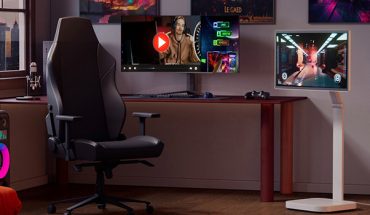From a handy home nail clipper to a sophisticated system for controlling computer functionality by mouth, a national non-profit organization operating in Canada is helping people with disabilities by not just using adaptive technologies but making them.
Through the collaborative efforts of staff members and volunteers, makers and users, the organization is supporting people by creating various accessible technology solutions using open-source designs and advanced 3-D printers.
Assistive technologies and accessibility solutions are products, devices and services that can enhance the capabilities of a person with a disability. Assistive technologies can be complex high-tech computerized devices, but also rather straightforward and simple tools, like a moulded plastic pencil grip that slips over a writing utensil.
It’s about supporting personal development, employment opportunities and overall quality of life for people with disabilities (although some of the inventions can help us all).
Makers Making Change is the non-profit initiative from the Neil Squire Society, supported by the Government of Canada, the B.C.-based Vancouver Foundation, and the Google Foundation.
With locations across Canada, the Neil Squire Society Makers Making Change project creates an environment in which hobbyists and students, corporations and engineers, users and community members and others can come together in a volunteer capacity to develop and build computer-based assistive technologies using 3-D printing platforms. Its crowdsourcing approach can help keep costs of developing and manufacturing assistive technologies down, while opening up the door to new innovative ideas.
In addition to holding maker events and community meetings, the organization has posted a library of open-source assistive technology projects online, with images and videos and instructions and reviews that help makers help people with disabilities in the community. Anyone can submit a design, and the designs are freely downloadable.
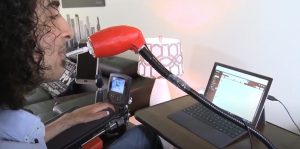
Omar demonstrates the LipSync, an assistive technology device developed as an open source project by Makers Making Change.
One of the organization’s benchmark developments is the LipSync device, a piece of assistive tech that enables quadriplegics to use touchscreen devices using a mouth-operated joystick with sip and puff controls (that create air pressure changes when someone sips or puffs on a connecting tube).
It’s an open-source hardware project, based on designs submitted by the community and then developed with
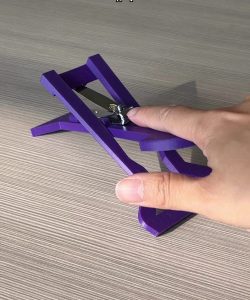
Flipper the Clipper is an open source assistive technology based on a contributed open source design. Attribution: Designed by Nisker_ (Thingiverse) and remixed from SONOKO.
the support of funding from Google and other corporate entities (at launch, for example, Bell Canada supported a build-a-thon of LipSync devices, with Makers Making Change technical advisors guiding Bell employees through the making process using 3-D printed parts, an Arduino Micro board and other electronics).
It’s been estimated that one million people in North America have limited or no use of their arms, so they’re unable to make full use of touchscreen devices and helpful apps and services with a device like the LipSync.
At the other end of the techno-sophistication scale from LipSync is Flipper the Clipper!
This simple yet functional piece of assistive technology (another design attributed to a volunteer contributor) lets people clip their nails using just one hand. The 3D printed device (it folds flat for storage or transportation) has notches that a regular nail clipper sits in. The device is one single printed item, costing about 75 cents in raw material.
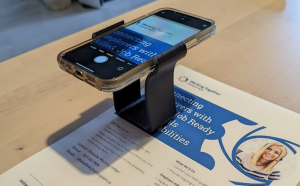
Another open source assistive gadget available at Makers Making Change is a smartphone holder.
Another simple assistive gadget available at Makers Making Change is a smartphone holder for those folks who use a smartphone as a magnifier. It holds a smartphone high enough from a book or page surface so the backside camera can fully focus on the object.
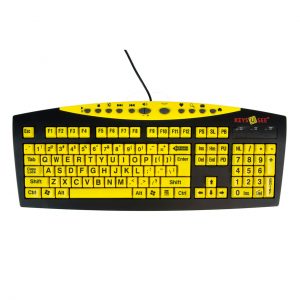
The KeyuSee keyboard offers visibility and usability benefits for many different people.
That has many uses for many people, be it reading of text, enlarging of graphics or taking steady close-up photos.
And the easy-to-see keyboard with extra large letters is also a boost for many of us, whether due to those aging eyes or those fading, worn-out characters on our store-bought keyboard.
The Neil Squire Society has been supporting the lives of Canadians, disabled or not, since 1984 through the use and development of assistive technology. Makers Making Change is one of the many programs it now offers.
The organization was established when 21-year-old Neil Squire became tetraplegic after a car crash. A basic but groundbreaking sip and puff technology was developed for him; the Society was formed in his name to help other people with disabilities after his passing.
As mentioned, Makers Making Change conducts build events and classes with members of the community interested in learning more about the Makers Making Change program, Assistive Technology and Adaptive Gaming. Participants can also gain hands-on making skills that include soldering, building and 3D printing.
Thursday, May 18, 2023 marks the 12th annual Global Accessibility Awareness Day (GAAD), during which everyone is encouraged to talk, think and learn about digital inclusion and computer access and assistive technology.

Assistive and adaptive technologies can help improve computer access and quality of life for disabled or physically challenged people. Image Creator: alexsl. Copyright: alexsl
-30-


